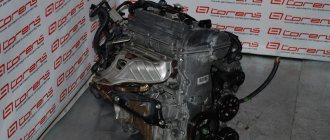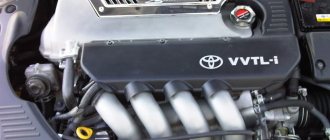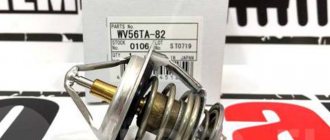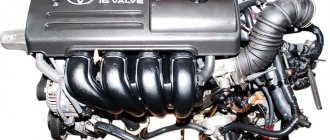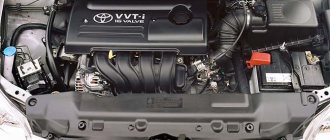The Japanese-made power unit was recently installed on Toyota vehicles intended for the domestic market. The 1ZZ engine entered the European and then the Russian car markets relatively recently. In all respects, it replaced its predecessor 3S-FE. Many motorists appreciated the high quality and excellent technical characteristics of the new 1 ZZ FE engine. They noted such obvious advantages as increased power indicators (120 - 140 horsepower) and the ultra-high reliability of the Japanese internal combustion engine.
Release of modifications of the Toyota 1ZZ-FE engine family
Over a long period of production of these engines, samples of various modifications were developed and produced:
- 1ZZ-FE.
- 1ZZ-FED.
- 1ZZ-FBE.
The Japanese manufacturer Toyota Motor Manufacturing West Virginia, located in Buffalo in the USA, was engaged in the manufacture of 1ZZ-FE. This engine is the most popular among the entire line; the 1ZZ FE engine was assembled over a period of nine years, starting in 1998. This engine has a power of about 140 hp. With.
Unlike the 1ZZ-FE, the design of the 1ZZ-FED power unit includes forged connecting rods of lighter weight.
The engine was assembled at the Japanese enterprise Shimoyama Plant.
The 1ZZ-FBE engine is designed to run on biofuel, in accordance with the E85 standard. It was produced for cars of the Brazilian market.
List of cars on which the Toyota 1 ZZ engine is installed:
- Toyota Corolla;
- Toyota Avensis;
- Toyota Caldina;
- Toyota Vista;
- Toyota Premio;
- Toyota Celica;
- Toyota Matrix XR;
- Toyota Allion;
- Toyota MR2;
- Toyota Opa;
- Toyota Isis;
- Toyota Wish;
- Lotus Elise;
- Toyota WiLL VS;
- Chevrolet Prizm;
- Pontiac Vibe.
Engine 1ZZ technical specifications
| Engine name | Toyota 1ZZ |
| Cylinder block and cylinder head material | Aluminum alloy with cast iron sleeves |
| Fuel system | Injector |
| Cylinder arrangement | Row |
| Number of cylinders | 4 things. Each cylinder has four valves |
| Piston stroke length | 91.5 mm |
| Engine capacity | 1794 cm3 |
| Power | 120 – 143 l. With. |
| Torque | 165 – 171 n.m rpm |
| Type of fuel | Gasoline AI 92 |
| Environmental Compliance | Euro 4 |
| Engine weight 1ZZ | 135 kg |
| Motor oil viscosity indicators | 5W-30, 10W-30. Synthetics. |
| Oil change interval | 5 – 10,000 km |
| 1ZZ FE engine resource | 200,000 km |
When driving on city highways with heavy traffic, gasoline consumption is over 10 liters. On country roads, the Toyota 1ZZ engine is the most economical - consumption is about 6.2 liters. When driving in mixed modes - 8 liters of gasoline, respectively.
Features of engine maintenance 1ZZ-FE
This motor is not particularly capricious; maintenance is carried out within certain periods stipulated by the regulations. The manufacturer has developed the following rules:
- Change the engine oil every 10 thousand kilometers.
- If a car with a Toyota 1ZZ engine is operated under heavy loads, this parameter is reduced to 5,000 km of travel.
- The valve clearances of the gas distribution mechanism need to be adjusted after a mileage of 20,000 km.
- The timing chain needs to be replaced with a new unit after 150 - 200,000 km.
Due to the fact that the Japanese Toyota 1ZZ-FE engine is a disposable type of mechanism, its overhaul is not feasible. Activities such as re-lining of cartridges are not carried out here; these actions are not provided for by the design. The main liners are also not subject to restoration. You can extend the life of the Toyota 1ZZ engine only by following the maintenance rules.
Malfunctions
The 1ZZ EF engine is quite well known to domestic car enthusiasts. Therefore, its weaknesses are also well studied. The most common faults are those listed in the table.
| DEFECTS | CAUSES | HOW TO FIX |
| Noise and knocking in the 1zz fe engine. | The timing chain has been stretched and may appear after 150 thousand kilometers. | 1. Replace the chain. 2. Check and, if necessary, replace the chain tensioner and damper. |
| The 1zz fe engine operates unstably (speeds fluctuate). | Clogged: 1. Idle air valve. 2. Throttle valve block. | Wash clogged parts. |
| High consumption of engine oil. | Worn oil scraper rings. | 1. Replace the oil scraper rings with new ones manufactured after 2005. 2. Increase the engine oil volume to 4.2 liters. Note: decarbonizing the rings does not eliminate the defect. |
| Strong vibration of the motor. (a characteristic feature of the motor). | The rear engine mount may fail. | Check and, if necessary, replace the rear mounting pad. |
How to extend the service life of the ZZ-FE engine
After studying numerous reviews on forums in which active motorists share their impressions, it was concluded that the 1ZZ-FE engine does not always maintain the promised resource of 250 thousand kilometers. It is not uncommon for it to stop after 150 - 200,000 km.
To achieve longer mileage on Toyota 1ZZ engines, it is recommended:
- operate the power unit in gentle modes;
- carry out maintenance activities within the recommended time frame;
- use lubricants of appropriate quality;
- monitor the serviceability of the cooling system elements.
When driving a vehicle with a Toyota 1ZZ-FE family engine installed, experienced drivers advise using a gentle operating mode. Particularly harmful are the so-called “kick-downs,” when the gas pedal is pressed sharply and the engine receives maximum load, for example, when overtaking on the highway or when climbing a mountain.
Timely replacement of engine oil is another equally important factor that has a significant impact on the long-term operation of this power unit. Of course, under normal operating conditions of the car, there is no need to rush to change the lubricant every two to three thousand kilometers, but 10,000 km is a sufficient mileage at which a good quality lubricant retains its technical characteristics.
Important condition: Do not allow the car to become oil starved, during which the service life of the internal combustion engine is significantly reduced.
It depends on the driver how correctly he chooses the brand of motor oil, depending on the following factors:
- car operating conditions,
- season,
- temperature conditions;
- viscosity coefficient,
- chemical composition,
- brand of lubricant and other important conditions.
If the cooling system does not provide complete heat removal from the rubbing elements of the Toyota 1ZZ-FE internal combustion engine, this leads to its overheating. The most vulnerable parts of this engine that suffer from overheating are the cylinder block and the cylinder head. Under the influence of high temperatures, products made of aluminum alloys are deformed and change their shape.
Description
Any 1ZZ engine is an in-line four-cylinder power unit whose cylinder block is made of aluminum alloy.
Thin-walled cast iron cylinder liners are fused into the material of the main block. The outer walls of the sleeves have structural elements that contribute to their strong adhesion to the base.
The cylinder head of the 1ZZ FE engine is made of aluminum alloy. The gas distribution mechanism is a 16-valve DONC.
Structurally, the cylinder block of the engines of this series differs from the others:
- cooling jacket open at the top. This made it possible to significantly improve manufacturability. At the same time, the strength of the block decreased slightly;
- massive light alloy crankcase, which is made integral with steel main bearing caps. The parting line between the crankcase and the cylinder block runs along the axis of the crankshaft, which increases the rigidity of the cylinder block and somewhat compensates for the loss of strength caused by the presence of an open cooling jacket.
The 1ZZ FE engine is a long-stroke engine with a piston stroke greater than the cylinder diameter. This solution made it possible to improve traction at low speeds and reduce heat loss through the walls of the combustion chamber, the volume of which was reduced.
The design of the valve seats is also of interest. In their manufacture, laser deposition technology was used, which made it possible not only to reduce the thickness of the seat, but also to improve the cooling of the valves.
The valves are adjusted using adjusting pushers of different thicknesses, the cups of which simultaneously act as a pusher and a washer. The timing mechanism is driven by a single-row roller chain.
The drive mechanism includes:
- remote hydraulic tensioner with a ratchet mechanism and a preload spring;
- special nozzle for lubrication;
- tensioner shoe;
- sedative
Tuning capabilities of the Japanese 1ZZ-FE engine
It is believed that engines of this family cannot be repaired, so their improvements are not advisable. However, among car owners there are many who want to increase the power of their power unit, bringing its value to 200 horsepower or higher, instead of the standard 120.
For this purpose, the following transformations are carried out:
- A high-quality Japanese-made Toyota SC14 compressor is installed, complete with a cooling intercooler.
- The standard fuel pump and injectors are dismantled and replaced with new units that have the highest performance.
Thanks to fine tuning of the Toyota 1ZZ engine operating systems, power increases to 300 horsepower and above. The described method has a significant drawback: to carry out these activities, considerable material investments will be required, exceeding the cost of a new internal combustion engine.
Crankcase ventilation valve (PCV) 12204-28020, 12204-22051 Toyota Avensis
As a rule, during periodic engine maintenance, spark plugs, filling fluids are changed and the throttle body is washed.
But few people have heard about the fact that when flushing the BDZ it is necessary to flush the crankcase ventilation valve. This small part can cause a lot of trouble that cannot be detected by either the built-in diagnostic system or the connected scanner: you will not see any errors.
What kind of valve is this and what is it for? It is part of the crankcase gas removal system. During normal operation of a serviceable engine, some of the combustion products through the sealing and compression rings still enter the lower part of the engine, called the crankcase, which contains oil. Its volume is practically sealed, and if measures are not taken to remove these gases, over time they will begin to dilute the oil, disrupting its lubricating properties, and the engine will eventually seize.
The crankcase ventilation system consists of pipes, one of which is connected to the outlet of the air filter, the second is connected through our valve to the throttle space, in which when the engine is running there is a pressure below atmospheric (vacuum). When the engine is running, it opens only in certain operating modes (usually at medium speeds), when the vacuum in the throttle space is higher than a certain value, which ensures “ventilation” of the crankcase.
Ventilation valve 12204-28020 for Toyota Avensis with 2AZFE engine:
Ventilation valve 12204-22051 for Toyota Avensis with 4ZZFE engine:
This is the horror you can see if you unscrew the valve (you will need a 22mm wrench and pliers to remove the clamp):
Most of the time, this valve must be closed; it opens due to vacuum in the throttle space only in certain engine operating modes, and only towards the suction manifold. In this way, environmental friendliness is achieved: exhaust gases with oil vapors are burned in the cylinders.
However, due to its coking, it begins to work in both directions, which, by the way, causes rapid contamination of the throttle valve. It also begins to allow some air to bypass the throttle valve in operating modes that do not provide for this: at idle and during acceleration.
At idle, this manifests itself in unstable speed, engine jerking and tachometer needle wandering. One gets the impression that the engine is about to stall, which is especially unpleasant when you are standing at a traffic light.
During sharp acceleration, when the throttle valve opens sharply, even before the engine spins up, the vacuum in the throttle space, according to calculations, should not be enough to open the crankcase ventilation valve (PCV), however, due to the fact that it is coked, some of the unaccounted air enters into the cylinders bypassing the throttle valve.

